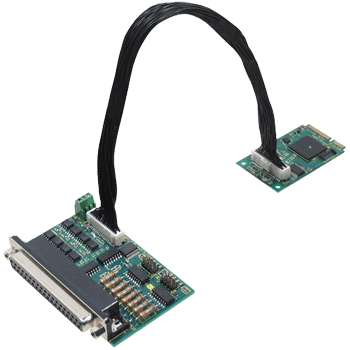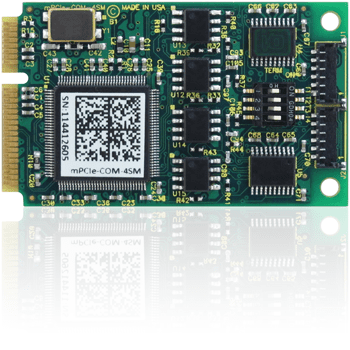PCIe/104-Based Data Acquisition (DAQ) and Control Products
PCIe/104-Based Data Acquisition (DAQ) and Control
SMALL FORM FACTOR EMBEDDED COMPUTER BOARDS

PCIe/104 boards are typically intended for use in small, space-constrained industrial control or vehicles systems. The standard size of these modules is just 3.550 × 3.775 inches (90 × 96 mm).
The name PC/104 comes from the original IBM computer known as the “PC”, and the number of pins used to connect the cards together (104). PCIe/104 boards, like PC/104 boards, are typically stacked on top of each other using stackable bus connectors and four mounting holes at the corner of each module. This provides a much more rugged, embedded computer that can be used in harsh environments such as those found in military or industrial applications.
These rugged, self-stacking modules, allow for an expandable system without the burden of a motherboard or backplane with a fixed number of slots. Additionally, since PCIe/104 is basically PCI Express with a different form factor, most of the program development tools used for PCs can be used for a PCIe/104 system. This reduces the cost of purchasing new tools and also greatly reduces the learning curve for programmers and hardware designers.
Almost anything you can think of is available as a PCIe/104 module. This includes common functions like CPUs, Analog, Digital, and Serial I/O ports, and Video Controllers; in addition to more special function modules like GPS receivers, vehicle power supplies, and wireless communications. A PCIe/104 stack can be attached as a component of a larger circuit board, or simply put in a small enclosure for stand-alone operation.
Since PCIe/104 systems are small and usually have low power requirements, they are traditionally used in applications that simply don’t have the space for a standard industrial computer or desktop PC. Some sample applications for this type of technology include the following: military applications, industrial control systems, vehicular systems, data loggers, aviation, vending machines, test equipment, medical instruments, and communications devices.
ACCES offers PCIe/104 I/O boards that include analog in, analog out, serial RS232, RS422, RS485, digital I/O, relay I/O and more. Additionally, ACCES has partnered with leading PC/104 CPU vendors to offer complete system solutions. By using PCIe/104, design and application engineers can easily and economically provide numerous configurations to customers requiring the strong and rugged characteristics of PCIe/104.
PCIe/104 Products
BROWSE OUR CURRENT OFFERINGS
PCI Express Mini Card (mPCIe) Expansion Sockets on PCIe/104
| Model | Description | mPCIe sockets | PCIe Lanes Needed | hf:att:pa_pcie-x1-expansion | hf:att:pa_pcie-lanes | |
|---|---|---|---|---|---|---|
| 104e-mPCIe-4A | One PCIe x1 lane to 4 mPCIe sockets Carrier Board | 4 | 1 | Show details | 4 | 1 |
| 104e-mPCIe-2A | One PCIe x1 lane to 4 mPCIe sockets Carrier Board | 2 | 1 | Show details | 2 | 1 |
| 104e-mPCIe-2 | Four PCIe x1 lanes to 2 mPCIe sockets Carrier Board | 2 | 2 | Show details | 2 | 2 |
| 104e-mPCIe-4 | Four PCIe x1 lanes to 4 mPCIe sockets Carrier Board | 4 | 4 | Show details | 4 | 4 |
Convenient Peripherals
| Model | Description | Learn More | |
|---|---|---|---|
 | mPCIe-AIO16-16FDS | mPCIe, 16 SE, or 8 Diff, or 8 SE and 4 Diff, 16-Bit, 1M x 2 Samples/s, AI; 2 DIO, 4 AO; Waveform Output | Learn More |
 | mPCIe-AIO16-16F | mPCIe, 16 SE, or 8 Diff, or 8 SE and 4 Diff, 16-Bit, 1M x 2 Samples/s, AI; 2 DIO, 4 AO | Learn More |
 | mPCIe-AIO16-16A | mPCIe, 16 SE, or 8 Diff, or 8 SE and 4 Diff, 16-Bit, 500K x 2 Samples/s, AI; 2 DIO, 4 AO | Learn More |
 | mPCIe-AIO16-16E | mPCIe, 16 SE, or 8 Diff, or 8 SE and 4 Diff, 16-Bit, 250K x 2 Samples/s, AI; 2 DIO, 4 AO | Learn More |
 | mPCIe-AI16-16F | mPCIe, 16 SE, or 8 Diff, or 8 SE and 4 Diff, 16-Bit, 1M x 2 Samples/s, AI; 2 DIO | Learn More |
 | mPCIe-AI16-16A | mPCIe, 16 SE, or 8 Diff, or 8 SE and 4 Diff, 16-Bit, 500K x 2 Samples/s, AI; 2 DIO | Learn More |
 | mPCIe-AI16-16E | mPCIe, 16 SE, or 8 Diff, or 8 SE and 4 Diff, 16-Bit, 250K x 2 Samples/s, AI; 2 DIO | Learn More |
 | mPCIe-AIO12-16A | mPCIe, 16 SE, or 8 Diff, or 8 SE and 4 Diff, 12-Bit, 500K x 2 Samples/s, AI; 2 DIO, 4 AO | Learn More |
 | mPCIe-AIO12-16 | mPCIe, 16 SE, or 8 Diff, or 8 SE and 4 Diff, 12-Bit, 250K x 2 Samples/s, AI; 2 DIO, 4 AO | Learn More |
 | mPCIe-AIO12-16E | mPCIe, 16 SE, or 8 Diff, or 8 SE and 4 Diff, 12-Bit, 100K x 2 Samples/s, AI; 2 DIO, 4 AO | Learn More |
 | mPCIe-AI12-16E | mPCIe, 16 SE, or 8 Diff, or 8 SE and 4 Diff, 12-Bit, 100K x 2 Samples/s, AI; 2 DIO | Learn More |
 | mPCIe-AI12-16A | mPCIe, 16 SE, or 8 Diff, or 8 SE and 4 Diff, 12-Bit, 500K x 2 Samples/s, AI; 2 DIO | Learn More |
 | mPCIe-AI12-16 | mPCIe, 16 SE, or 8 Diff, or 8 SE and 4 Diff, 12-Bit, 250K x 2 Samples/s, AI; 2 DIO | Learn More |
 | mPCIe-QUAD-4 | 4-Channel Quadrature Input PCI Express Mini Card | Learn More |
 | mPCIe-QUAD-8 | 8-Channel Quadrature Input PCI Express Mini Card | Learn More |
 | mPCIe-ADIO16-8FDS | mPCIe, 8 SE or 4 Diff, 16-Bit, 1M Samples/s, AI; 16 DIO, 4 AO, Waveform Output | Learn More |
 | mPCIe-ADIO16-8F | mPCIe, 8 SE or 4 Diff, 16-Bit, 1M Samples/s, AI; 16 DIO, 4 AO | Learn More |
 | mPCIe-ADIO16-8A | mPCIe, 8 SE or 4 Diff, 16-Bit, 500K Samples/s, AI; 16 DIO, 4 AO | Learn More |
 | mPCIe-ADIO16-8E | mPCIe, 8 SE or 4 Diff, 16-Bit, 250K Samples/s, AI; 16 DIO, 4 AO | Learn More |
 | mPCIe-ADI16-8F | mPCIe, 8 SE or 4 Diff, 16-Bit, 1M Samples/s, AI; 16 DIO | Learn More |
 | mPCIe-ADI16-8A | mPCIe, 8 SE or 4 Diff, 16-Bit, 500K Samples/s, AI; 16 DIO | Learn More |
 | mPCIe-ADI16-8E | mPCIe, 8 SE or 4 Diff, 16-Bit, 250K Samples/s, AI; 16 DIO | Learn More |
 | mPCIe-ADIO12-8A | mPCIe, 8 SE or 4 Diff, 12-Bit, 500K Samples/s, AI; 16 DIO, 4 AO | Learn More |
 | mPCIe-ADIO12-8 | mPCIe, 8 SE or 4 Diff, 12-Bit, 250K Samples/s, AI; 16 DIO, 4 AO | Learn More |
 | mPCIe-ADIO12-8E | mPCIe, 8 SE or 4 Diff, 12-Bit, 100K Samples/s, AI; 16 DIO, 4 AO | Learn More |
 | mPCIe-ADI12-8A | mPCIe, 8 SE or 4 Diff, 12-Bit, 500K Samples/s, AI; 16 DIO | Learn More |
 | mPCIe-ADI12-8 | mPCIe, 8 SE or 4 Diff, 12-Bit, 250K Samples/s, AI; 16 DIO | Learn More |
 | mPCIe-ADI12-8E | mPCIe, 8 SE or 4 Diff, 12-Bit, 100K Samples/s, AI; 16 DIO | Learn More |
 | mPCIe-IIRO-4 | mPCIe, 4 Isolated Inputs, 4 Form C (SPDT) Relay Outputs | Learn More |
 | mPCIe-RO-8 | mPCIe, 5 Form C (SPDT) & 3 Form A (SPST) Relay Outputs | Learn More |
 | mPCIe-IIRO-8 | mPCIe, 8 Isolated Inputs, 5 Form C (SPDT) & 3 Form A (SPST) Relay Outputs | Learn More |
 | mPCIe-IDIO-4 | mPCIe, 4 Isolated Inputs, 4 Solid-State Relay Outputs | Learn More |
 | mPCIe-IDIO-8 | mPCIe, 8 Isolated Inputs, 8 Solid-State Relay Outputs | Learn More |
 | mPCIe-IDO-8 | mPCIe, 4 Solid-State Relay Outputs | Learn More |
 | mPCIe-DIO-24X | 24 Digital I/O mPCIe Card with Digital Integration Features on all I/O bits | Learn More |
 | mPCIe-DIO-24A | 24 Digital I/O mPCIe Card with Digital Integration Features on 8 outputs and 8 input bits | Learn More |
 | mPCIe-II-4 | mPCIe, 4 Isolated Inputs | Learn More |
 | mPCIe-II-8 | mPCIe, 8 Isolated Inputs | Learn More |
 | mPCIe-II-16 | mPCIe, 16 Isolated Inputs | Learn More |
 | mPCIe-UCAN2-ISO | Two port CANbus mPCIe card, with Isolation | Learn More |
 | mPCIe-UCAN2 | Two port CANbus mPCIe card | Learn More |
 | mPCIe-ICM422-1 | One-port isolated RS422 PCI Express Mini Card | Learn More |
 | mPCIe-ICM422-2 | Two-port isolated RS422 PCI Express Mini Card | Learn More |
 | mPCIe-ICM422-4 | Four-port isolated RS422 PCI Express Mini Card | Learn More |
 | mPCIe-ICM485-1 | Single-port isolated RS-485 PCI Express Mini Card with industrial operating temperature | Learn More |
 | mPCIe-ICM485-2 | 2-port isolated RS-485 PCI Express Mini Card with industrial operating temperature | Learn More |
 | mPCIe-ICM485-4 | 4-port isolated RS-485 PCI Express Mini Card with industrial operating temperature | Learn More |
 | mPCIe-ICM232-2 | mPCIe with two-port isolated RS232 | Learn More |
 | mPCIe-ICM232-4 | mPCIe with four-port isolated RS232 | Learn More |
 | mPCIe-DIO-24 | mPCIe 24 x Digital I/O Card, No CoS | Learn More |
 | mPCIe-DIO-24S | mPCIe 24 x Digital I/O Card w/CoS IRQ | Learn More |
 | mPCIe-COM232-2 | mPCIe, 2-Port RS-232 | Learn More |
 | mPCIe-COM-2S | mPCIe 2-Port Multi-Protocol RS-422/485 | Learn More |
 | mPCIe-COM-2SM | mPCIe 2-Port Multi-Protocol RS-232/422/485 | Learn More |
 | mPCIe-COM232-4 | mPCIe 4-Port RS-232 | Learn More |
 | mPCIe-COM-4S | mPCIe 4-Port Multi-Protocol RS-422/485 | Learn More |
 | mPCIe-COM-4SM | mPCIe 4-Port Multi-Protocol RS-232/422/485 | Learn More |
 | mPCIe-LAN-GbE | mPCIe Gigabit Ethernet LAN Card | Learn More |
 | mPCIe-ISODIO-16 | Isolated Digital Input & Output mPCIe Card | Learn More |
